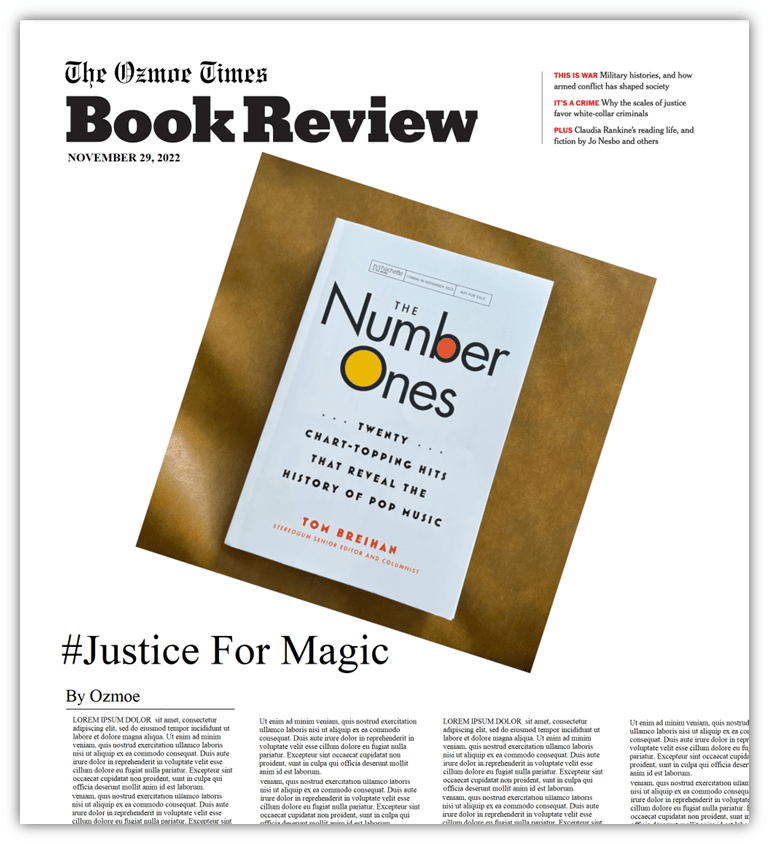After months of anticipation, Tom Breihan’s book The Number Ones: Twenty Chart-Topping Hits That Reveal the History of Pop Music is now available in print. Woo hoo!
Now we get to rate a book from the guy who’s been rating all the Number Ones on Billboard’s Hot 100 on the Stereogum website since 2018.
Turnabout is fair play, as they say!

In doing so, for my part: I’m using the same 1-10 scale. (1 is worst, 10 is best) that Tom uses to assess each song he reviews. I’m rating the book in the following three categories:
1: The Selections

Among the 20 songs Tom profiles in depth, he wisely listed some with a huge cultural impact, such as I Want to Hold Your Hand and Billie Jean.
But I have issues with others that made the cut and a few that were left out.
For example, Bon Jovi’s You Give Love a Bad Name is included for making room for “hair metal” on the chart. To me, you should instead go back to the source of what led to hair metal:
That’s the Rolling Stones, whose influence on the Hot 100 is so immense that its lead singer got name-checked in the 2011 Number One hit Moves Like Jagger. To omit the Stones’ first chart topper, 1965’s (I Can’t Get No) Satisfaction, is I believe the book’s biggest oversight. They were a harder rocking and more bluesy counterpart to the Beatles who influenced dozens of other groups who later had number one hits – including Bon Jovi.

I also would’ve liked an entry focusing more on the growth of the singer-songwriter, such as something by Elton John or Stevie Wonder. Neither have a featured song here, which given their impact and longevity in the music industry seems like another missed opportunity.
To me, the growth of the singer-songwriter was a major trend in the 1970s, a decade underrepresented in the book with only two entries. One of the latter is Rock Your Baby, which Tom claims is the first disco song to go number one even though Rock the Boat preceded it.
Regardless, including the first disco song without the biggest one seems odd… like if Tom had started with the rock era and put Rock Around the Clock with nothing from Elvis Presley.
I would’ve replaced Rock Your Baby with Stayin’ Alive by the Bee Gees, who also aren’t featured, despite the Saturday Night Fever soundtrack dominating the top of the Hot 100 for much of 1978, and setting in motion the notion of how just how big soundtracks could become.
Also dissatisfying me is naming Ice Ice Baby as the first number one rap song. This is even more subjective than claiming the first disco chart topper was Rock Your Baby (another song with “baby” in the title—didn’t realize that until now!).
Nothing Tom writes dissuades me from the opinion that two-hit wonder Vanilla Ice is the least substantial act to merit an essay in the book.

Other major artists missing in representation among the twenty profiled are Madonna, Whitney Houston, Janet Jackson, Beyoncé, Rihanna, Drake, and Lady Gaga. You’ll notice that most are women. Indeed, the only female solo artists represented are Mariah Carey and Britney Spears.
Even if you count Stevie Nicks’ lead vocal on Dreams, plus the Shirelles and the Supremes, that still leaves only a quarter of Tom’s profiled songs having vocals from the distaff direction.
Tom could’ve and should’ve done better here. Indeed, many of the hits by Janet, Beyoncé, Rihanna, and Lady Gaga during the aughts hold up better to my ears than the two picks he makes for that decade—Buy You a Drank (Shawty Snappin’) by T-Pain and Crank That (Soulja Boy) by Soulja Boy Tell’em, both in 2007.

Still, the good choices outweigh the more dubious ones overall. I’m fine with 14 of the 20 songs selected, so, for this part, that proportion reduces to a rating of 7/10.
2: The Information

Think you know everything about the connections in the rap world regarding Can’t Nobody Hold Me Down? Or that Wikipedia has all you need to know about Good Vibrations?
Wrong on both counts.
Tom does a stellar job researching every song. I learned something even about the ones where I thought he couldn’t tell me anything new. I had no idea until I read his entry on The Twist that Chubby Checker’s daughter Mistie Bass won a WNBA championship in 2014, for example.
That said, the editors did miss a few errors. Billy Ocean’s hit Loverboy is referred to as “Loverman.” And the release year for the Beach Boys’ Fun, Fun, Fun is given as 1965 instead of 1964 in a sentence noting that it was competing for listeners against I Want to Hold Your Hand.

But these are minor quibbles. What’s left is so packed with details, that I give this part a rating of … 9/10
3: The Composition

This book is a quick and easy read thanks to Tom’s always incisive writing.
He describes how and why records sound, and what he thinks of those results better than any other author I’ve encountered. Even when I disagree with him on an issue, like grouping The Hustle among a list of 1975 disco Number Ones as “unashamedly silly novelties from acts that would soon disappear,” I usually understand his reasoning.
You don’t – and shouldn’t – have to agree with all assessments critics make about every record. However, you should be able to see why they made the decision, and even reconsider your thoughts about it in light of what they say.

For doing that excellently,
I give this part a rating of … 10/10!
Compiling these three scores, I get a total of 26/30, which comes out to 8.66 or so, which rounds up to a final score of …

My hearty recommendation is that you get the book.
(Even with still no apology for giving Olivia Newton-John’s 1980 hit a “3”. #justiceformagic)
What do you think, especially if you’ve read the book too?
Please share your comments below and be happy to disagree with me if needed.





So glad you also caught the “Loverman” as it jumped right out at me and made me question who copy-edited the book … as I finished it, though, I wondered whether maybe it was a troll to see how many of us would catch it.
Completely by accident, this is the first book I’ve purchased in hard copy (preordered months ago) and on Kindle (a more recent order when I couldn’t find a record of the hard copy order). I actually think the book’s blend of readability and reference work makes it a fine work to have in both media.
My favorite thing about the book, which I think you did a fine job of assessing, is how thorough each entry is. Reading about one song, you learn not only about it or its artist (as you do in the regular columns), but because of the comprehensive nature of the book, each entry makes stylistic connections and even cross-genre links that show how Tom has paid attention to the broad sweep of pop music history. It’s an impressive effort indeed.
And, yeah, the callout to TNOCS (if not by name) in the introduction was sweet.
Great job, Ozmoe.
My copy is due to arrive today, should be waiting for me when I get home from work tonight. So I can’t weigh in just yet, but I’m definitely looking forward to reading it.
Thanks for the preview ozmoe!
As always, a few thoughts:
Thoughts?
I agree that the book is more Link-friendly, to coin a phrase, and all the better for it. Honestly I feel like he’s used the “I love that $h!t” sentence way too much recently, and I’m guessing we’re up for more of the same.
Yeah!
So perfectly pitched to Monday’s Number One.
Indeed. Now I wonder….
Is that a yelping Ursh-urrr ‘Yeah!’?
Or an emphatic Lil Jon ” Yeah!”?
Sorry, I can’t help but gravitate towards a blinged-out grille Link image.
This Yeah!
I would definitely be down for a “should have been number one” book on culturally important singles. Or…a column of the same once he runs out of #1 material/patience. 😀
Sounds like something you’d do a good job writing, Phylum. If only there was a website where you could publish such a column….
As they say in my neighborhood:
“Don’t worry. I got a guy. You’re all set.”
I would have fun reading such a column (hint hint), but chart performance is not really my wheelhouse.
Now, a more general “forgotten or misunderstood gems” series, that might be fun to write.
Definitely agree with you about the language, thegue, which may have been a gentle (or not-so-gentle) nudge from his editors to be more family friendly for the book. I think it was wise for him to do so in that regard.
As for his sequel ideas, I’ve heard about the diamond albums idea and am fine but not wild about it. It certainly beats the other one he mentioned in his Billboard interview about profiling all the rap chart number ones, which I’m sure won’t get the same readership he has now. Just look at the substantial variations of usually 2-3 points less TNOCS listeners have given on average for the recent rap entries versus Tom’s score. He obviously loves the genre more than our group at large, and I don’t think we’d be as interest in following it.
Now, 20 songs that didn’t make number one and should have, I’d definitely read that! I’d start with the Beatles and something from Sgt. Pepper’s Lonely Hearts Club Band as an example of album cuts ineligible for charting, naturally the whole Baker Street fiasco that calls into question the chart activity from 1974-83 (and there were some real oddities during that period), and like you said Don’t Speak, which I still hear a lot and deservedly so more than half of the other 1990s chart toppers. But it’s Tom’s decision to make ultimately of course.
P.S. Sorry, your review got my brain churning, so I forgot to say GREAT WRITEUP.
(as if my 1200 word response didn’t give it away!)
Ha ha, no worries, thegue!
Like thegue, I’m going to have to familiarize myself with some of the later tunes, but I can’t start the book just yet. I got a copy for my son as a Christmas present and he’s still here for his Thanksgiving visit. I don’t want to spoil the surprise.
Besides, he loaned me Chris Kluwe’s “Otaku” which I need to finish and return.
Nice review, Ozmoe! Well done.
I haven’t read it yet. I was told not to buy it, as Christmas is coming, so it will probably be the new year before I have the chance. Based on your review, I can’t wait.
Nice, thanks for the recommendation!
I will have to pick it up eventually, though to be honest I like this type of content much more in column form rather than book. Still, it’s good to be supportive!
Once I finally slog through God-Emperor of Dune, and Alan Moore’s Jersusalem, that is…
Wasn’t “Ice Ice Baby” the first rap song to reach #1 on the Hot 100? I agree that there’s a ton of more interesting songs to write about, and mere “first” status doesn’t necessarily justify inclusion in such a limited selection of write-ups.
To that end, i can understand why people might be miffed about Souljah Boy’s inclusion in the book…though I personally love that song. 😅
Thanks for the review Ozmoe. I wasn’t sure if the book would have much to add on top of the columns already available but sounds like there’s plenty more content. I’ve already got a stack of 5 books to get through and more coming for Christmas so it’ll be a while before I get on to it. I like to buy in bulk and spend a good hour or so browsing the book store before making my purchases and whenever I go anywhere there’s an independent book store I’ll support them and top up the pile with another couple of purchases.
Currently reading Bob Stanley’s (one of St Etienne in his day job) prequel to his history of pop music; Yeah Yeah Yeah – this one titled Lets Do It. This one covers ‘popular music’ from 1900 to the birth of rock and roll. It covers a whole lot of ground and styles, hugely informative and entertaining and giving colour to a lot of names I’m familar with without actually being too familar with their music.
Highly recommend it if anyone has got through Tom’s book and wants to get their Gershwin on.
I’m about 3/4 of the way through the book (I’m normally a fast reader, but am reading this one slow to really take it in) – I’m really liking how Tom is using one song to discuss many artists and genres – it’s exactly the kind of expansion I would have expected when converting a three-a-week column to a book.
I’m also surprised at the less-than-perfect copy editing – there’s a sentence that talks about Gun N’ Roses.
Excellent stuff so far – I’m learning a lot.
And..
#JusticeForMagic
@Ozmoe thank you for the review, I ask a cousin to buy the book, so fingers crossed that she will bring to me next January.
In some of Tom’s interviews about the book, I could realize some of the omissions and, man, “Crank That (Soulja Boy)” is a song that I don’t remember listening at all back in the day and I have no idea if it’s relevant or it was just Tom’s taste.
I’m not much of a book-buyer. I would love to read this one at a library and return it, but maybe I’ll bite the bullet and get it. I would love to read it.
Link, if you use Kindle, I recommend getting it that way. Less expensive and much more user-friendly for, say, sitting at a restaurant waiting on a friend.
I got that reference, cstolliver, ha ha! See you Sunday!
This book is on my Christmas list, so I’ll be able to chime in about 27 days from now.
In the meantime, the chart geek in me was compelled to find the Hot 100 template mt used for his section headings. It’s from October 8, 1988 (with a bullet added to #3). I’m proud to say (somewhat nerdily) that my first guess was correct, as #2 had to be “Red Red Wine”. 🤓
I am more than impressed with your sleuthing skills.
You deduced that from so few clues, A-3K? That is astounding!
24 weeks on for a song making that big of a jump to #2 in that era was the giveaway!
Dude, Aaron, this just might be the most incredibly awesome example of investigative nerdiness I’ve read in ages.
Standing ovation from the peanut gallery on that, good sir. Well done.
9/10, nice!
…the same rating Tom should’ve given “Don’t Go Breaking My Heart”.
You know, we could probably do a blog entry on here about the number one songs where Tom really gave the wrong ratings. That would be Magic, Don’t Go Breaking My Heart and so on.
The strangest thing happened to me the other day. I was listening to the radio, and the O’Jays record, “Backstabbers“ came on.
As I listened, I thought to myself, “You know, this is an excellent record. It’s really good. In fact, you might say: If you were going to rank it, or rate it using, oh, say, some sort of numerical system, you might be inclined to give it as many points as your scale was designed for. Perhaps even a 10 point rating out of 10 points. But, hey, what do I know.
I’m just saying.
So lame, my Barnes and Noble. Ten years ago, B&N and Borders would have carried it. I always give brick and mortar a shot.
(sigh)
Amazon. There is no escaping Amazon.